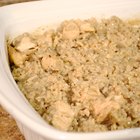Leftovers and small amounts of ingredients can be combined into casseroles that you assemble and freeze weeks ahead of time. Then you have a quick, balanced meal on evenings when you don't have time to cook. Casseroles tend to be dense, so they must be properly thawed to avoid overcooking them during the reheating process. A casserole can take up to two days to thaw in the refrigerator, but if you need to heat one for a meal at the last minute, thaw it in the microwave first.
Step 1
Take the casserole out of the freezer. Discard any foil. Cover the dish securely with a piece of microwave-safe plastic food wrap. Poke a few holes across the top of the plastic wrap to allow moisture to escape.
Step 2
Place the casserole in the microwave. Use your microwave's automatic defrost setting to thaw the casserole, which usually runs about six minutes, depending on the brand. Set older model microwaves on low, or half power, to defrost your casserole.
Step 3
Check the casserole at about three minutes. Your microwave may sound an alert at this point, depending on the model. Lift the plastic wrap and push the fork into the middle of the casserole. If you meet resistance, replace the plastic wrap, put the dish back in the microwave, and complete the defrost cycle. You may need to run the cycle twice, depending on the casserole's density.
Step 4
Transfer the casserole to the oven immediately after thawing it to begin the reheating process. This ensures that the casserole doesn't enter the food safety danger zone where bacteria grow rapidly, between 41 and 140 degrees Fahrenheit. Insert a food thermometer into the casserole at several locations to make sure it reaches 160 F before you serve it.
Related Articles

How to Cook Penne Rigate Noodles in the ...

Baked Chicken & Rice With Mushroom Soup

How to Reset My MIO Watch

How to Cook a Broccoli and Rice ...

How to Change the Date on Bulova Watches

Instructions for a Casio AW590 Watch

Pulsar Chronograph Watch Instructions

How to Replace the Watch Battery in a ...

Instructions for a Seiko Perpetual

How to Reheat Lasagna

How to Cook Dry Garbanzos in a Crock Pot

How to Stop AARP Mail

How to Replace the Battery in a ...

How to Change the Time on the Casio ...

How to Reset a Polar F6 that is Locked ...

How to Freeze Empanadas

How Many Calories are in Cheese Lasagna?

Instructions for a G-Shock 2688 ...

How to Set the Alarm on The Timex ...

How Long After a Sell-By Date Can You ...
References
Tips
- If your kitchen tends to get warm during the summer, remove the casserole from the freezer, seal it in a plastic bag and place it in a bath of cool tap water in your kitchen sink. Refresh the water frequently. Although not nearly as quick as a microwave, the warmer ambient temperature hastens the defrosting process. Monitor the casserole closely and transfer it to the oven or microwave for complete reheating as soon as it thaws.
Writer Bio
Maya Black has been covering business, food, travel, cultural topics and decorating since 1992. She has bachelor's degree in art and a master's degree in cultural studies from University of Texas, a culinary arts certificate and a real estate license. Her articles appear in magazines such as Virginia Living and Albemarle.